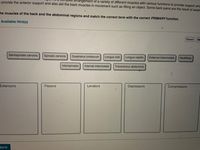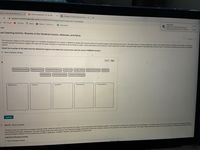
Human Anatomy & Physiology (11th Edition)
11th Edition
ISBN: 9780134580999
Author: Elaine N. Marieb, Katja N. Hoehn
Publisher: PEARSON
expand_more
expand_more
format_list_bulleted
Question

Transcribed Image Text:### Educational Resource: Understanding Muscle Functions in the Back and Abdominal Regions
This interactive exercise helps students match various muscles with their primary functions. It focuses on muscles in the back and abdominal regions and categorizes them based on their main roles.
#### Muscle Options:
- **Semispinalis cervicis**
- **Spinalis cervicis**
- **Quadratus lumborum**
- **Longus colli**
- **Longus capitis**
- **External intercostals**
- **Multifidus**
- **Interspinales**
- **Internal intercostals**
- **Transversus abdominis**
#### Function Categories:
- **Extensors**
- **Flexors**
- **Levators**
- **Depressors**
- **Compressors**
Students need to drag each muscle into the appropriate function box. For example, some muscles might function primarily as extensors, helping in extending the spine, while others might be involved in flexing, lifting, or compressing parts of the body.
The exercise encourages understanding of anatomical functions and strengthens knowledge of biomechanics.
Use the "Available Hint(s)" for guidance or click "Reset" to start the exercise over if needed. Once all muscles are placed into their categories, students can submit their answers for feedback.

Transcribed Image Text:**Lab Coaching Activity: Muscles of the Vertebral Column, Abdomen, and Pelvis**
The muscular makeup of the dorsal region is a complex arrangement of various muscles with functions to provide support while allowing movement. The back moves in multiple directions: anterior and lateral flexion, extension, and rotation. Abdominal muscles provide anterior support and aid back muscles in movements such as lifting objects. Some back pains result from weak abdominal muscles. Along with back support, the abdominal muscles help to compress the abdomen and flex the vertebral column.
**Activity Instructions:**
Study the muscles of the back and the abdominal regions and match the correct term with the correct **PRIMARY** function.
- View Available Hint(s)
**Muscles List:**
- Semispinalis cervicis
- Spinalis cervicis
- Quadratus lumborum
- Longus colli
- Longus capitis
- External intercostals
- Interspinales
- Internal intercostals
- Transversus abdominis
- Multifidus
**Function Categories:**
- Extensors
- Flexors
- Levators
- Depressors
- Compressors
**Submit Button**
**Part D - Pelvic Muscles**
The pelvic floor and wall form a complex muscular sheet called the perineum that supports the organs of the reproductive and digestive systems. The perineum is divided into urogenital and anal triangles. The anterior edge of the anus forms the base of the urogenital triangle, and its apex is the pubic symphysis. The anal triangle shares the same base as the urogenital triangle, except that it forms the posterior portion of the perineum and peaks at the coccyx. The major muscle forming the pelvic floor is the levator ani. Within each triangle, there are various muscles involved in functions such as urination, defecation, childbirth, erection, and ejaculation, to name a few.
**Label the following muscles.**
- View Available Hint(s)
Expert Solution
This question has been solved!
Explore an expertly crafted, step-by-step solution for a thorough understanding of key concepts.
This is a popular solution
Trending nowThis is a popular solution!
Step by stepSolved in 2 steps

Knowledge Booster
Similar questions
- bea 04:00 1 remaining before your computer restarts automatically. thexis Youromputer must restart to complete the installation of applications and soft ware updates. clerosis copy RESTART SNOOZE tenosis CENGAGE Learning DEFINITIONS Select the correct answer, and write it on the line provided. 1.21. describes any pathologic change or disease in the spinal cord. The term myelopathy myopathy pyelitis ругosis 1.22. The medical term for higher-than-normal blood pressure is hepatomegaly hypertension hypotension supination 1.23. The term means pertaining to birth. natal perinatal postnatal prenatal 1.24. Pain is classified as a diagnosis sign symptom syndrome 1.25. In the term myopathy, the suffix -pathy means abnormal cor welling 19 of 27 Enter your answer ch DELLarrow_forwardCorrectly label the following muscles of the poseterior viewarrow_forwardMatching !arrow_forward
- What would be the best answer?arrow_forwardStylo proces -Styloglessus Geniog yoglosaus Hyoid bone Mestering APSudy Are E mr svdes e Etrinale mscles of the onguand ocited upratyoldmles Figure 11.10 Musdes of mastication and tongue mevement, left lateral view. Muscles of the Neck Origin Insertion Action Sternocleidomastoid Scalene Muscles Splenius Musclesarrow_forwardName_Stephanie Goodwin A soccer player was playing goalie and tripped while playing, and it appears that when she fell she fractured her arm halfway between the wrist, and elbow since it is in the shape of an S and it appears to be an open fracture. You are there watching the game, and volunteer to assist since nobody else has any first aid training. What would you do? First steps taken: Scene? ABC? Explain how you would check each one A C How should the injury be taken care of next? (Do PRICE) M & 6. 41 yarrow_forward
- O Logout Successful BPearson's MyLab & Mastering X MasteringAandP: Ex 20 HW Q Muscles of the Low A session.masteringaandp.com/myct/itemView?assignmentProblemID=171858680&offset3Dnext E Apps M Gmail O YouTube O Maps B Week 6- 3275.12.. Grammarly KEx 20 HW Exercise 20 Review & Practice Sheet: Muscles of the Pectoral Girdle and Upper Limb First dorsal interosseous muscle Brachioradialis Extensor carpi radialis longus Tendon of extensor indicis Extensor pollicis brevis Tendon of extensor pollicis longus Abductor pollicis longus Extensor carpi radialis brevis Submit Request Answerarrow_forwardLab Ex 9 - Šaved - Search ces Mailings Review View Help A Aa v A AaBbCcl AaB AaBb Body Text Heading 1 Heading 2 x² ev Av Paragraph Styles List the three meningeal lavers in the correct order...from the CNS outwards. It might help to remember the mnemonic PADS. P. A Skin Matching: Place a number in front of each structure, pia mater gray matter of cerebral cortex white matter of cerebrum dura mater sub arachnoid space arachnoid mater skull bones arachnoid villi superior sagittal sinus Which structure is responsible for returning CSF back to the blood? 10 _In which space is CSF found? A condition where there is elevated level of CSF in brain Provide three functions of CSF: N !!! 三arrow_forwardHomework 2 Describe briefly muscles of thigh region & create a table showing a summary of these muscles (pdf format) that includes origin insertion nerve supply action deadline will be at FRIDAY 12/3/2021 at 9 pm Home Work!arrow_forward
arrow_back_ios
arrow_forward_ios
Recommended textbooks for you
 Human Anatomy & Physiology (11th Edition)Anatomy and PhysiologyISBN:9780134580999Author:Elaine N. Marieb, Katja N. HoehnPublisher:PEARSON
Human Anatomy & Physiology (11th Edition)Anatomy and PhysiologyISBN:9780134580999Author:Elaine N. Marieb, Katja N. HoehnPublisher:PEARSON Anatomy & PhysiologyAnatomy and PhysiologyISBN:9781259398629Author:McKinley, Michael P., O'loughlin, Valerie Dean, Bidle, Theresa StouterPublisher:Mcgraw Hill Education,
Anatomy & PhysiologyAnatomy and PhysiologyISBN:9781259398629Author:McKinley, Michael P., O'loughlin, Valerie Dean, Bidle, Theresa StouterPublisher:Mcgraw Hill Education, Human AnatomyAnatomy and PhysiologyISBN:9780135168059Author:Marieb, Elaine Nicpon, Brady, Patricia, Mallatt, JonPublisher:Pearson Education, Inc.,
Human AnatomyAnatomy and PhysiologyISBN:9780135168059Author:Marieb, Elaine Nicpon, Brady, Patricia, Mallatt, JonPublisher:Pearson Education, Inc., Anatomy & Physiology: An Integrative ApproachAnatomy and PhysiologyISBN:9780078024283Author:Michael McKinley Dr., Valerie O'Loughlin, Theresa BidlePublisher:McGraw-Hill Education
Anatomy & Physiology: An Integrative ApproachAnatomy and PhysiologyISBN:9780078024283Author:Michael McKinley Dr., Valerie O'Loughlin, Theresa BidlePublisher:McGraw-Hill Education Human Anatomy & Physiology (Marieb, Human Anatomy...Anatomy and PhysiologyISBN:9780321927040Author:Elaine N. Marieb, Katja HoehnPublisher:PEARSON
Human Anatomy & Physiology (Marieb, Human Anatomy...Anatomy and PhysiologyISBN:9780321927040Author:Elaine N. Marieb, Katja HoehnPublisher:PEARSON

Human Anatomy & Physiology (11th Edition)
Anatomy and Physiology
ISBN:9780134580999
Author:Elaine N. Marieb, Katja N. Hoehn
Publisher:PEARSON

Anatomy & Physiology
Anatomy and Physiology
ISBN:9781259398629
Author:McKinley, Michael P., O'loughlin, Valerie Dean, Bidle, Theresa Stouter
Publisher:Mcgraw Hill Education,

Human Anatomy
Anatomy and Physiology
ISBN:9780135168059
Author:Marieb, Elaine Nicpon, Brady, Patricia, Mallatt, Jon
Publisher:Pearson Education, Inc.,

Anatomy & Physiology: An Integrative Approach
Anatomy and Physiology
ISBN:9780078024283
Author:Michael McKinley Dr., Valerie O'Loughlin, Theresa Bidle
Publisher:McGraw-Hill Education

Human Anatomy & Physiology (Marieb, Human Anatomy...
Anatomy and Physiology
ISBN:9780321927040
Author:Elaine N. Marieb, Katja Hoehn
Publisher:PEARSON